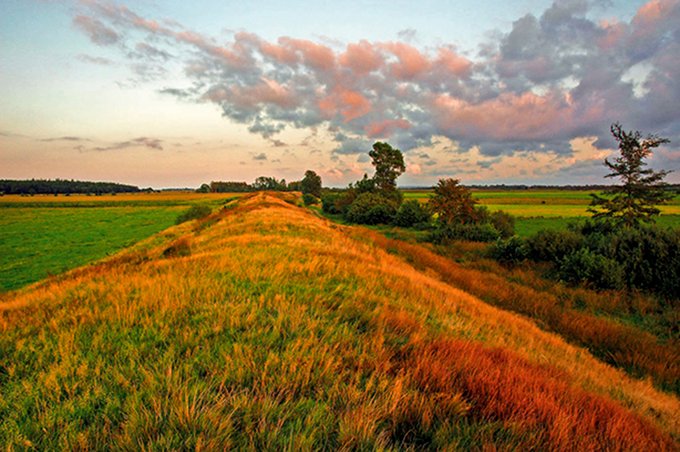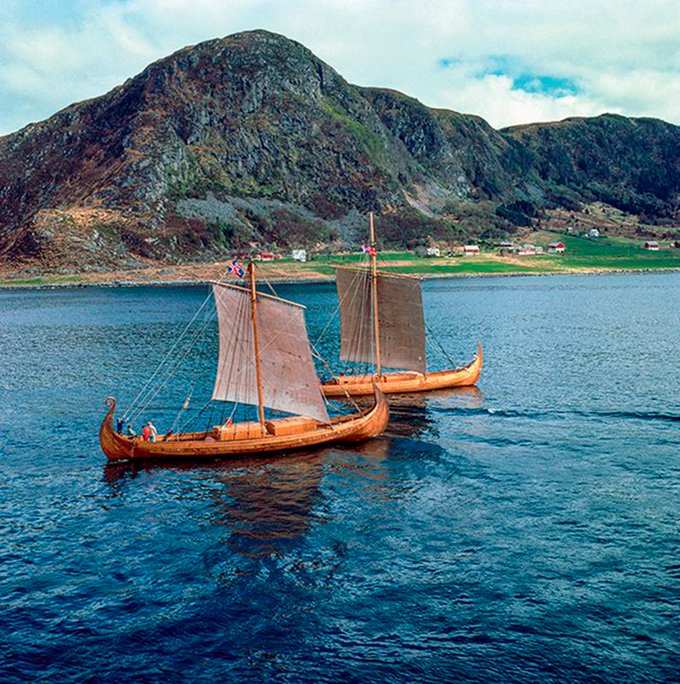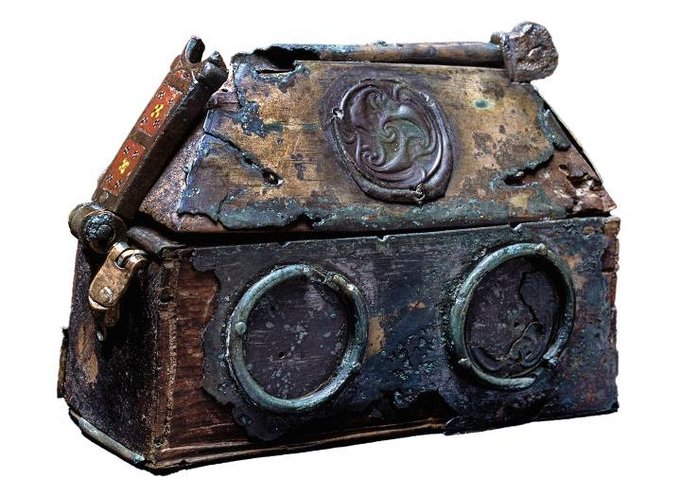1. The beginning of the Viking Age
The beginning of the history of Denmark cannot be set precisely. We can follow the cultural history of the landscapes which were to become the kingdom of Denmark in ancient times, from the first migration of hunters at the end of the last Ice Age. A dramatic political story of kingdoms, kings and armies unfolded across these landscapes in the Iron Age (c. 500 BC–AD 790), and probably even earlier, as shown by large finds of sacrificed war booty. But the history of Denmark as a recognisable political entity began to take shape during the Late Iron Age and the Viking Age (c. AD 790–1050).
Iron-Age warrior society
In the first centuries after Christ’s birth, as the Roman empire expanded across western and central Europe, organised warrior societies developed along the northern European frontier. For tribes and families in what the Romans called Germania Libera, the riches of the Roman empire became a focal point. Arms and combat technology became a primary competitive parameter. Chieftains built armies and alliances and took part in conflicts with each other or against the Romans, or went into Roman service. At the same time, Roman luxury goods such as drinking cups and jewellery became the elite’s favourite status symbols. Culturally, elements from Roman mythology were adopted, as was writing – in the form of the runic alphabet, which began to be used in Denmark around AD 150. Rich graves with weapons or Roman imports found all over Scandinavia reflect these warrior communities and their culture.
When crises weakened the Roman military, large Germanic armies were able to join forces and push back against Roman border defences in the hope of acquiring land within the Roman empire, or concluding peace agreements, which could be very profitable. The aim was to profit from the Roman empire, rather than to defeat it. Attacks could be carried out across land borders or across the sea; during the fourth century Germanic naval attacks became an increasing problem on the English coasts. Germanic tribes may have sailed in vessels like the Nydam boat, an oak-built rowing boat approximately 24 metres long, built around the year 320 and found in the Nydam bog near the island of Als. It could have accommodated some forty-five warriors. This boat, better than any other single archaeological find, demonstrates how parts of the military and maritime technology that became the basis of the Viking Age had their origins several centuries earlier.
The great migrations and the climate crisis of Late Antiquity
When the frontier defences of the western Roman empire collapsed in the late fourth century, thousands of Germanic immigrants moved into the former Roman provinces. In many places, the Germanic armies established independent kingdoms. During the Great Migration Period (c. 400–550), people emigrated from present-day Denmark to England, where Angles, Saxons and Jutes settled in large numbers. Others captured quantities of silver or gold, much of which was transformed into jewellery and ornaments. The most famous example is the Golden Horns of Gallehus, two large horns of solid gold ornamented with elaborate images. At this time, gold gained an almost magical status among the Germanic peoples – a status that still resounded in the poetry of the Viking Age some five hundred years later. Archaeological finds, however, give no indication that the homelands were depopulated at this time, as has sometimes been suggested. Up to the beginning of the sixth century, traces of farms, villages, graves and hoards are still numerous in the Danish landscapes. The migrations did not emanate from destitute regions.
In the mid-sixth century, large parts of the northern hemisphere were hit by two serious environmental crises. The first was a sustained period of severely cold weather. We now know that this was triggered by a series of large volcanic eruptions, the first of which took place in the years AD 535– 536. In the short term, the result was several years of failing harvest yields and ensuing famine, which were described in, among other places, contemporary Irish sources. The eruptions spawned a global cooling that was felt for several decades and is known as the Late Antique Little Ice Age. The second crisis occurred from the year 541, and may well have been related to the first. From this point on, the Mediterranean region and subsequently other parts of the European continent were hit by a deadly bubonic plague. DNA research has established that the Justinian Plague, named after the Eastern Roman emperor Justinian I, was similar to the fourteenth-century Black Death. Across large parts of northern Europe, there is a marked decrease in the quantity of archaeological finds and settlement traces from the second half of the sixth century. At the same time, pollen analyses and other environmental proxies show that large areas rapidly reverted to forest. These two findings may be interpreted as indications that together the climate-induced crisis and the plague decimated the population. The plague, like the Black Death of the Middle Ages, may have created recurring epidemics over several generations, and the result may have been the same – namely a general decrease in population. New settlers moved into the best agricultural areas, while less fertile regions may have become depopulated. Against this background, the seventh century stands out from the periods both before and after. Both written sources and archaeological remains show traces of contacts and exchanges across the continent, although the capacity and incentive for large raids and migrations had dropped to a minimum.
Trading towns and sea kings
At some point in the seventh century, this trend began to reverse. In many regions, settlements became larger and denser. Places like the islands of the Wadden Sea, for centuries largely depopulated, were resettled. A network of small maritime trading towns or emporia emerged for the first time in the North Sea region, from York and London in England to Dorestad and Domburg in Holland and, around the year 700, Ribe in Denmark. Within a few decades, the first emporia also emerged around the Baltic Sea: Rerik near Wismar, Åhus in Skåne, Truso in eastern Poland and – in the second half of the eighth century – Birka near Stockholm. These towns offered many kinds of goods, from glass beads and whetstones to furs and padlocks. Trade was well organised, based on small silver coins known as sceattas. One such coin type, the Wodan/Monster coin, has been found especially in Ribe, and was probably struck here – the earliest minting on Danish soil.
The rise of emporia or trading towns demonstrates that a surplus was once again accumulating in some regions, which could be invested in contacts with the world beyond. Finds of heavy goods such as wine barrels and quernstones show that sailing ships must have been an important part of transportation. It was the growing reach of sailing ships and their crews that made the emporia – the first towns in Scandinavia – attractive as places where merchants met and cargoes could be traded and distributed.
These contacts were not always peaceful. Fortifications and sea barrages in fjords from far back in the Iron Age are known to archaeologists, but large military installations intended to control the sea also appeared around the time of the first trading towns. At Kanhave on the island of Samsø, where a narrow isthmus connects the north and south ends of the island, a canal more than a kilometre long was dug in 726 and strengthened with wooden sides. The canal allowed a fleet to move out quickly on both sides of the island and thus to control the central waters between Jutland, Fyn and Sjælland. Given the concentration of manpower that this large-scale construction work must have required, the power behind it was probably not a mere local power, but rather a king.
A border to the south was protected by a great rampart, the oldest parts of which were erected around the year 500. Written sources from around 1200 named this border rampart Danevirke, but the name, meaning ‘the defence of the Danes’, was much older. During the Viking Age and the High Middle Ages, the rampart was extended with several earthen embankments, palisades, walls and sea barrages. The Danevirke stretched across the southeast part of Jutland from the important trading town Hedeby on the Schlei to the river Treene towards the west. The Danevirke and Hedeby were recognised in 2018 as UNESCO World Heritage sites. Photo: © Archäologisches Landesamt Schleswig-Holstein
At about the same time, the Danevirke rampart near the present-day city of Schleswig was greatly expanded. The oldest parts of these earthworks date back to around the year 500, but in the 730s the defences were extended with a strong oak palisade and large wooden barrage on the Schlei. As with the Kanhave canal, these large constructions testify to a naval monarchy capable of co-ordinating defences and convening labour from a large area.
Warriors, missionaries and sailing ships
We get a glimpse of the threats that the sea could bring from an archaeological find from Salme in Estonia. Around 750 two ships were buried on the seashore, along with part of their crew. The dead warriors were buried with weapons, and bore traces of fierce fighting. DNA and isotope analyses show that they came from Sweden and Gotland. The find tells us that ships were used for war expeditions before the Viking Age. However, it is unclear whether the ships from Salme had sails, as Viking-Age ships definitely did a few generations later. At this time the sail had been in use for centuries in the Mediterranean and on the French and English coasts. But it was an expensive technology and one that only gained ground in Scandinavia during the eighth century.
The sea journeys and the early emporia in the region were described in the accounts of English missionaries, who began to follow in the wake of the merchants at about this time. Among others, the historian Bede gave an account of how evangelists like the monk Willibrord set out to convert the ancient tribes of the Anglo-Saxons across the North Sea to the east. According to a later chronicle composed by the scholar Alcuin at Charlemagne’s court, Willibrord reached the shores north of Heligoland, where he encountered a Danish king called Ongendus, probably a Latinised version of the name Angantyr.
Reconstructions of the Oseberg and Gokstad ships sailing off Ulstenvik in Norway. The original ships were found in graves and were built around the years 820 and 890 respectively. They are the best-known examples of the advanced craftsmanship and technical skills that lay behind the Early Viking-Age maritime transformations. Large clinker-built rowing boats had been known in Scandinavia since the Roman Iron Age (100–400 AD), but the addition of large square- rigged sails and the adaptation of the hull improved the ships’ seaworthiness in open sea and increased their load capacity. The introduction of this technology required a great effort with regard to shipbuilding and navigation. Photo: © David Lomax
Many scholars have been tempted to see this king as a strong Danish ruler, possibly the originator of the Kanhave canal, the Danevirke and Ribe’s first coins. Some, however, suspect the name and the story to be Alcuin’s own invention, perhaps added to give the Anglo-Saxon Willibrord, who was a relative of Alcuin, credit for the first Christianising mission among the Danes. Either way, we are told that Ongendus had no mind to be converted. As a consolation, Willibrord found some goodwill among the Frisians in the Wadden Sea area, and some support among the Franks, who looked with favour on their Frisian neighbours becoming Christianised.
The Frankish empire
The Frankish empire, which at this time included large parts of present-day France and Belgium as well as Germany west of the Rhine, was the largest of the political entities founded during the Great Migration Period among the remnants of the western Roman empire. In the mid-eighth century its old royal dynasty, the Merovingians, was deposed by an influential prince from the eastern parts of the kingdom, Charles Martel. He became the ancestor of the Carolingian dynasty, which was to carry out a spectacular expansion, creating a Frankish empire which, in the early ninth century, might have appeared to be a revival of the western Roman empire. This was a key development in the political history of northern Europe between c. 750 and 850.
By the end of the eighth century, Europe was thus divided between Christian kingdoms south of the Rhine and in the British Isles, and pagan tribes and peoples in the lands to the north. North of the Rhine, the Frankish kings led a belligerent conquest policy which, under Charles Martel’s grandson, Charlemagne, reached the regions around Hamburg. Like their opponents – the Saxons, the Frisians and, before long, the Danes – the Franks descended from Iron-Age warrior society. Like them, they had inherited the myths of the Great Migration Period as well as a masculine code of honour revolving around fearless fighting, fame and treasure won in battle, although they had also absorbed the Christian culture of the late Roman empire.
The beginning of the Viking Age
Shortly before the year 800, the chroniclers began to report raids and looting of monasteries by pagan sailors along the Irish and English coasts. There had been some previous skirmishes, but the oldest securely dated attack took place in 793 at the abbey of Lindisfarne in northern England. The attack became widely known because the target was a famous spiritual centre. It terrified Alcuin, among others, and he mentioned the disaster in several letters. Other attacks soon followed.
The earliest attacks probably came from western Norway, geographically closest to the targeted areas, where many finds of Irish and English jewellery and other items from the Early Viking Age have been made. The oldest actual archaeological find of a sailing ship in Scandinavia was also Norwegian: the almost fully preserved ship from the Oseberg grave in southern Norway, built around the year 820. Researchers have speculated that these Viking attacks followed generations of peaceful contacts across the North Sea, but the archaeological evidence no longer sustains this view. It remains likely that the early Viking raids reflected a new form of contact made possible by sailing across the open sea, facilitated in turn by the opportunities brought on by sailing technology and perhaps also by the increasingly detailed geographical knowledge that could be accumulated from other travellers in trading towns like Ribe.
The Melhus reliquary was found in a rich grave from the Early Viking Age in central Norway. It is one of several pieces of church furnishings and other objects from the British Isles that have been found in graves and buildings from this time in Scandinavia. Some were kept whole, like this reliquary, while others were cut up and turned into jewellery. This also applies in Denmark, where a number of finds in recent years have been made using metal detectors. Finds from the British Isles from the centuries before the Viking Age are largely unknown in Scandinavia. It is therefore likely that the arrival of these finds can be linked to the early Viking expeditions. Photo: NTNU Vitenskabsmuseet in Trondheim
Regardless of these changes, no one at the time would have thought that they had now entered a new era, the ‘Viking Age’. At the time, the word ‘Viking’ was used to denote sea warriors or maritime warfare. As a historical concept, the period came to be defined in the nineteenth century, as part of the construction of national histories in the Scandinavian countries. At this point it was introduced as a technical term for the centuries that belonged neither to the prehistoric, pagan past (which archaeologists had recently divided into Stone, Bronze and Iron Ages) nor to the Middle Ages (which Scandinavian historians then associated with the Catholic Church) – the latter signifying the period between conversion and the Church reformations of the sixteenth century.
European historians of the nineteenth century used the word ‘Vikings’ interchangeably with ‘Northmen’ and ‘Danes’. The former was accepted among Scandinavian archaeologists, perhaps because it did not stir Nordic national rivalries and amplified the central theme in the sources of this period – wars and piracy carried out by sea kings and chieftains. Many later historians have written off the concept as a modern construction, born of national romanticism and legends. Some researchers today see the period as a part of the Iron Age or the Middle Ages, and certainly the continuity is clear in both cases. If today we retain the word, which has gained common usage, it is still best understood in the sense in which it was introduced: to name an age when sailing and maritime warfare brought about far-reaching change in societies.


